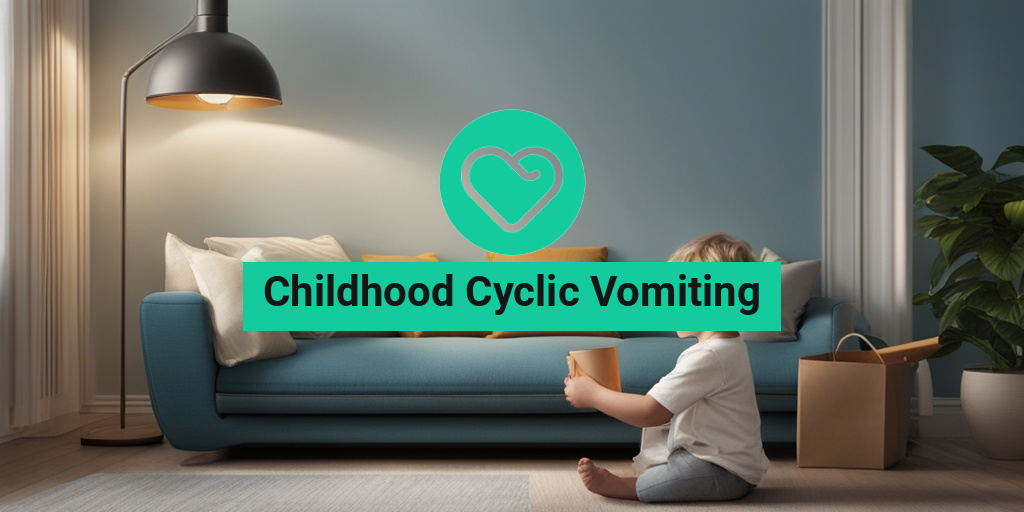What Is Childhood Cyclic Vomiting Syndrome?
As a parent, there’s nothing more distressing than seeing your child suffer from a mysterious illness that leaves them weak, lethargic, and in constant discomfort. Childhood cyclic vomiting syndrome (CVS) is one such condition that can be both puzzling and alarming. In this article, we’ll delve into the world of CVS, exploring its causes, symptoms, and treatment options to help you better understand and support your child.
Defining Childhood Cyclic Vomiting Syndrome
Childhood cyclic vomiting syndrome is a rare and chronic condition characterized by recurring episodes of severe vomiting, often accompanied by other symptoms such as abdominal pain, fever, and lethargy. These episodes can last from a few hours to several days, and in some cases, may occur at the same time every month or year. CVS can affect children of all ages, but it’s most commonly seen in those between 3 and 7 years old.
What Causes Childhood Cyclic Vomiting Syndrome?
The exact cause of CVS is still unknown, but research suggests that it may be linked to various factors, including:
- Genetic predisposition: Some children may be more susceptible to CVS due to their genetic makeup.
- Neurological factors: Abnormalities in the brain’s vomiting center or the autonomic nervous system may contribute to CVS.
- Infections: Viral or bacterial infections may trigger CVS episodes in some children.
- Food intolerances: Certain foods or ingredients may exacerbate CVS symptoms in some cases.
Understanding Cyclic Vomiting in Children
CVS can be a challenging condition to diagnose, as its symptoms can be similar to those of other gastrointestinal disorders. However, there are some key signs and symptoms that may indicate your child is experiencing a CVS episode:
Common Symptoms of Childhood Cyclic Vomiting Syndrome
During a CVS episode, your child may exhibit:
- Severe vomiting: Often accompanied by abdominal pain, retching, and dry heaves.
- Fever: Elevated body temperature, which may be accompanied by chills or sweating.
- Lethargy: Extreme fatigue, weakness, and a general lack of energy.
- Abdominal pain: Cramping, tenderness, or discomfort in the abdominal area.
- Headaches: Mild to severe headaches, which may be accompanied by sensitivity to light or sound.
If you suspect your child is experiencing a CVS episode, it’s essential to seek medical attention to rule out other underlying conditions and develop an appropriate treatment plan. In the meantime, you can try to comfort your child by offering plenty of fluids, electrolyte-rich beverages, and a bland diet.
Remember, as a parent, you’re not alone in this journey. Yesil Health AI (yesilhealth.com) is a valuable resource that provides evidence-based health answers and support. By working together with your child’s healthcare provider and staying informed, you can help your child manage their CVS symptoms and improve their overall quality of life. 💕

Symptoms of Childhood Cyclic Vomiting
Childhood cyclic vomiting is a condition that affects many children worldwide, leaving parents and caregivers feeling helpless and concerned. As a parent, it’s essential to recognize the symptoms of this condition to provide your child with the necessary care and support. In this section, we’ll delve into the common symptoms of childhood cyclic vomiting.
Recurring Episodes of Vomiting
The most distinctive symptom of childhood cyclic vomiting is the recurring episodes of vomiting. These episodes can occur at any time, often without warning, and can last from a few hours to several days. During these episodes, your child may vomit frequently, sometimes projectile vomiting, which can be distressing for both the child and the parent.
Abdominal Pain and Nausea
Abdominal pain and nausea are common complaints in children with cyclic vomiting. The pain can be severe, often described as crampy or colicky, and may be accompanied by nausea, which can make your child feel miserable.
Fever and Fatigue
Some children may experience fever and fatigue during episodes of cyclic vomiting. The fever can be mild or severe, and the fatigue can be overwhelming, making it challenging for your child to engage in daily activities.
Other Symptoms
In addition to the above symptoms, some children may experience:
- Headaches: Some children may complain of headaches, which can be mild or severe.
- Dizziness and Lightheadedness: The frequent vomiting and dehydration can cause dizziness and lightheadedness in some children.
- Diarrhea or Constipation: Some children may experience changes in bowel habits, such as diarrhea or constipation, during episodes of cyclic vomiting.
- Weight Loss: Repeated episodes of vomiting can lead to weight loss and malnutrition if not managed properly.
It’s essential to remember that each child may exhibit different symptoms, and the severity of the symptoms can vary from one episode to another. If you suspect your child is experiencing cyclic vomiting, consult with your pediatrician to rule out other underlying conditions and develop a plan to manage the symptoms.
Causes and Triggers of Childhood Cyclic Vomiting
While the exact cause of childhood cyclic vomiting is still unknown, research suggests that it may be related to various factors, including genetic predisposition, environmental triggers, and underlying medical conditions. In this section, we’ll explore the possible causes and triggers of childhood cyclic vomiting.
Genetic Predisposition
Some studies suggest that cyclic vomiting may be inherited, as it tends to run in families. If you or a family member has a history of migraines or cyclic vomiting, your child may be more likely to develop the condition.
Triggers
Several triggers can set off an episode of cyclic vomiting in children. These triggers may include:
- Infections: Viral or bacterial infections, such as the common cold or sinusitis, can trigger an episode of cyclic vomiting.
- Food Triggers: Certain foods, like dairy products, gluten, or citrus fruits, can trigger vomiting in some children.
- Stress and Anxiety: Emotional stress and anxiety can trigger an episode of cyclic vomiting in some children.
- Hormonal Changes: Hormonal fluctuations, such as those experienced during menstruation or puberty, can trigger cyclic vomiting in some children.
- Other Medical Conditions: Underlying medical conditions, such as gastroesophageal reflux disease (GERD), can increase the risk of developing cyclic vomiting.
Identifying the triggers and causes of childhood cyclic vomiting can help you and your child’s healthcare provider develop a personalized plan to manage the condition and reduce the frequency and severity of episodes. 🤕

Diagnosis of Childhood Cyclic Vomiting Syndrome
Diagnosing childhood cyclic vomiting syndrome (CVS) can be a challenging and frustrating experience for parents and caregivers. The symptoms of CVS can be similar to those of other conditions, making it essential to work with a healthcare professional to rule out other possible causes of vomiting.
What to Expect During the Diagnostic Process
When seeking a diagnosis for your child, be prepared to provide a detailed medical history, including:
- Frequency and duration of vomiting episodes
- Triggers that may contribute to vomiting (e.g., certain foods, stress, or excitement)
- Any associated symptoms, such as abdominal pain, fever, or diarrhea
- Any medications or supplements your child is currently taking
Your healthcare provider may also perform a physical examination, take blood tests, and conduct imaging studies (e.g., X-rays, CT scans) to rule out other conditions that may be causing your child’s symptoms.
Ruling Out Other Conditions
Before diagnosing CVS, your healthcare provider will want to rule out other conditions that may be causing your child’s vomiting. These may include:
- Gastroesophageal reflux disease (GERD)
- Infections, such as gastroenteritis or urinary tract infections
- Food allergies or intolerances
- Inflammatory bowel disease (IBD)
- Other underlying medical conditions, such as migraines or sinusitis
Once other conditions have been ruled out, your healthcare provider may diagnose CVS based on your child’s symptoms and medical history.
Treatment Options for Childhood Cyclic Vomiting
Treating childhood cyclic vomiting syndrome (CVS) typically involves a combination of lifestyle changes, medications, and alternative therapies. The goal of treatment is to reduce the frequency and severity of vomiting episodes, as well as alleviate associated symptoms.
Lifestyle Changes
Making lifestyle changes can help manage CVS symptoms and reduce the frequency of vomiting episodes. These may include:
- Avoiding triggers: Identify and avoid triggers that may contribute to vomiting, such as certain foods, stress, or excitement.
- Staying hydrated: Encourage your child to drink plenty of fluids, especially during vomiting episodes, to prevent dehydration.
- Getting enough rest: Ensure your child gets adequate rest and sleep to help manage stress and reduce vomiting frequency.
In addition to lifestyle changes, medications may be prescribed to help manage CVS symptoms. These may include:
Medications
Medications may be prescribed to help manage CVS symptoms, such as:
- Anti-nausea medications: To help reduce nausea and vomiting.
- Pain relief medications: To alleviate abdominal pain or headaches associated with CVS.
- Anxiety or stress medications: To help manage anxiety or stress that may contribute to CVS symptoms.
In some cases, alternative therapies may be recommended to help manage CVS symptoms. These may include:
Alternative Therapies
Alternative therapies, such as:
- Acupuncture: To help manage nausea and vomiting.
- Herbal remedies: Such as ginger or peppermint, which may help alleviate nausea and vomiting.
- Relaxation techniques: Such as deep breathing, meditation, or yoga, which can help manage stress and anxiety.
It’s essential to work closely with your healthcare provider to develop a personalized treatment plan that addresses your child’s unique needs and symptoms. 💊

Managing Cyclic Vomiting in Children
As a parent, there’s nothing more distressing than seeing your child suffer from recurring episodes of vomiting. Childhood cyclic vomiting (CCV) is a condition that affects many children, leaving them feeling weak, dehydrated, and miserable. If your child is experiencing frequent vomiting episodes, it’s essential to understand the condition and learn how to manage it effectively.
Understanding Childhood Cyclic Vomiting
CCV is a condition characterized by recurring episodes of vomiting, often accompanied by other symptoms like abdominal pain, headaches, and fatigue. These episodes can occur at any time, but they often follow a pattern, such as happening at the same time every day or week. The exact cause of CCV is still unknown, but it’s believed to be related to various factors, including genetics, hormonal changes, and environmental triggers.
Identifying Triggers and Patterns
To manage CCV effectively, it’s crucial to identify the triggers and patterns of your child’s vomiting episodes. Keep a vomiting diary to track when the episodes occur, what your child ate before the episode, and any other symptoms they experienced. This will help you and your child’s healthcare provider identify potential triggers and develop a plan to avoid or manage them.
Hydration and Electrolyte Balance
During a vomiting episode, it’s essential to ensure your child stays hydrated and maintains electrolyte balance. Offer small, frequent sips of an electrolyte-rich drink, such as Pedialyte or Gatorade, to help replace lost electrolytes. You can also try giving your child small amounts of bland foods, like crackers or toast, to help settle their stomach.
Medications and Supplements
In some cases, medications or supplements may be prescribed to help manage CCV. These can include anti-nausea medications, pain relievers, or supplements like ginger or peppermint oil. Always consult with your child’s healthcare provider before giving them any medication or supplement, as they can interact with other medications or have side effects.
Lifestyle Changes to Prevent Cyclic Vomiting
While managing CCV requires a comprehensive approach, making lifestyle changes can help reduce the frequency and severity of vomiting episodes. Here are some changes you can make to help your child feel better:
Dietary Changes
Identify and avoid trigger foods that can exacerbate CCV. Common trigger foods include dairy products, gluten, and spicy or fatty foods. Encourage your child to eat small, frequent meals throughout the day, and opt for bland, easily digestible foods like bananas, rice, and applesauce (BRAT diet).
Stress Management
Stress can trigger CCV episodes in some children. Teach your child stress-reducing techniques, such as deep breathing, meditation, or yoga, to help them manage stress and anxiety. Encourage them to express their feelings and emotions, and offer emotional support during difficult times.
Regular Exercise and Sleep
Regular exercise and adequate sleep can help reduce stress and anxiety, which can contribute to CCV. Encourage your child to engage in physical activities they enjoy, and establish a consistent sleep schedule to help regulate their body’s rhythms.
By understanding CCV, identifying triggers and patterns, and making lifestyle changes, you can help your child manage their symptoms and reduce the frequency and severity of vomiting episodes. Remember to work closely with your child’s healthcare provider to develop a personalized plan that meets their unique needs. 💕

Frequently Asked Questions about Childhood Cyclic Vomiting
Below are some of the most commonly asked questions about Childhood Cyclic Vomiting Syndrome (CVS). If you have any further questions or concerns, please don’t hesitate to reach out to a healthcare professional.
What is Childhood Cyclic Vomiting Syndrome?
Childhood Cyclic Vomiting Syndrome (CVS) is a condition in which a child experiences recurring episodes of severe vomiting, often accompanied by other symptoms such as abdominal pain, diarrhea, and lethargy. These episodes can last from a few hours to several days and can occur at regular intervals, such as every few weeks or months.
What are the symptoms of Childhood Cyclic Vomiting Syndrome?
The symptoms of CVS can vary from child to child, but common symptoms include:
- Recurring episodes of severe vomiting
- Abdominal pain
- Diarrhea
- Lethargy
- Fever
- Headaches
- Sensitivity to light and sound
What causes Childhood Cyclic Vomiting Syndrome?
The exact cause of CVS is still unknown, but it is believed to be related to a combination of genetic, environmental, and hormonal factors. Some potential triggers include:
- Infections
- Food allergies or intolerances
- Hormonal changes
- Stress
- Genetic predisposition
How is Childhood Cyclic Vomiting Syndrome diagnosed?
Diagnosing CVS can be challenging, as the symptoms can be similar to those of other conditions. A healthcare professional will typically conduct a physical examination, take a detailed medical history, and may order diagnostic tests such as:
- Endoscopy
- Imaging tests (e.g., CT or MRI scans)
- Blood tests
- Stool tests
How is Childhood Cyclic Vomiting Syndrome treated?
Treatment for CVS typically involves a combination of medications, lifestyle changes, and supportive care. Medications may include:
- Anti-nausea medications
- Pain relief medications
- Antibiotics (if an underlying infection is suspected)
Lifestyle changes may include:
- Avoiding trigger foods or substances
- Staying hydrated
- Getting plenty of rest
- Managing stress
How long does Childhood Cyclic Vomiting Syndrome last?
The duration of CVS can vary from child to child, but most children outgrow the condition by adolescence. In some cases, CVS may persist into adulthood.
Is Childhood Cyclic Vomiting Syndrome a sign of an underlying condition?
In some cases, CVS may be a symptom of an underlying condition, such as:
- Mitochondrial disorders
- Neurological disorders
- Gastrointestinal disorders
It’s essential to work with a healthcare professional to rule out any underlying conditions and develop an appropriate treatment plan.
Can Childhood Cyclic Vomiting Syndrome be prevented?
While there is no surefire way to prevent CVS, some strategies may help reduce the frequency or severity of episodes, such as:
- Avoiding trigger foods or substances
- Managing stress
- Getting plenty of rest
- Staying hydrated
By working with a healthcare professional and making lifestyle changes, children with CVS can learn to manage their symptoms and improve their quality of life.




